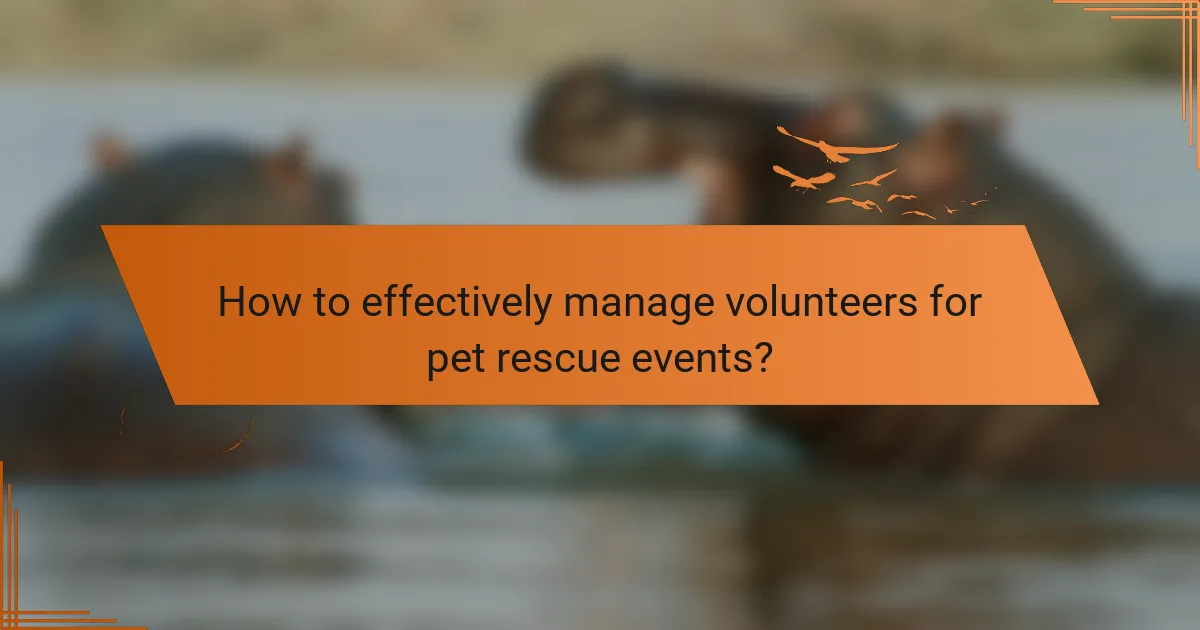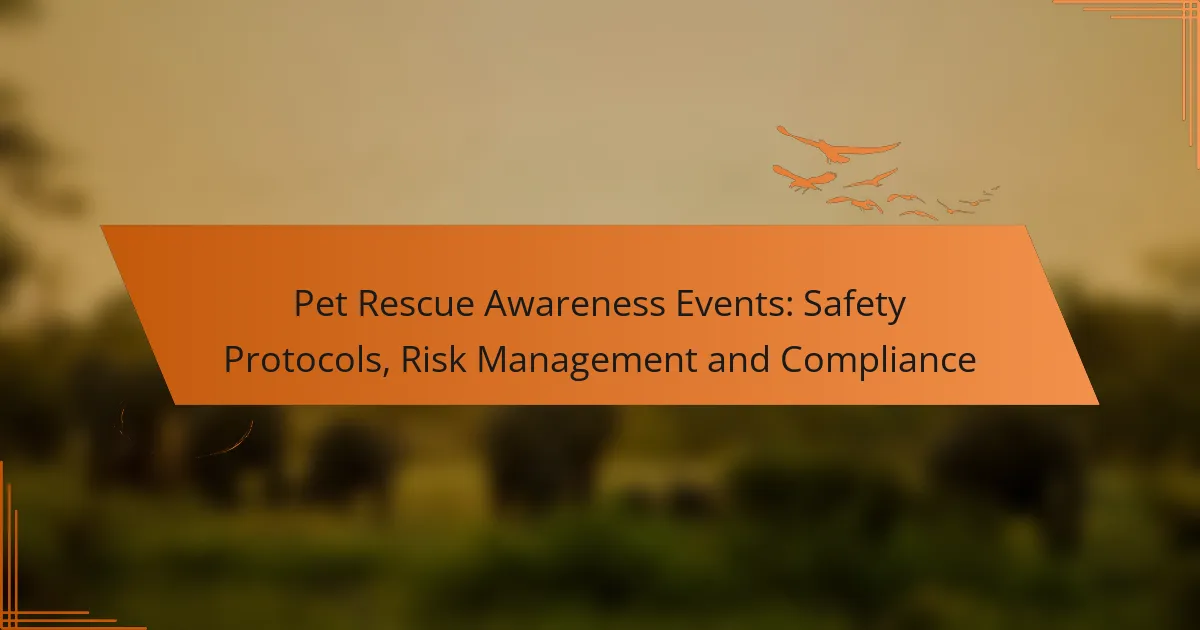Organizing a pet rescue awareness event requires careful planning and execution to effectively engage the community and promote animal welfare. Key elements include establishing clear objectives, managing logistics such as permits and vendor coordination, and fostering a supportive environment for volunteers. By addressing these critical aspects, you can create a successful event that not only raises awareness but also inspires action within your community.

How to plan a successful pet rescue awareness event in the USA?
Planning a successful pet rescue awareness event in the USA involves clear objectives, understanding your audience, and effective logistics. By focusing on these key areas, you can create an impactful event that raises awareness and encourages community involvement.
Define event goals
Clearly defining your event goals is crucial for its success. Consider whether you aim to raise funds, increase adoptions, or educate the public about pet care and rescue efforts. Establishing specific, measurable objectives will guide your planning process and help evaluate the event’s effectiveness.
For example, if your goal is to raise funds, set a target amount that reflects your organization’s needs and the resources available for the event. This clarity will inform your subsequent decisions, from budgeting to marketing.
Identify target audience
Understanding your target audience is essential for tailoring your event to their interests and needs. Consider demographics such as age, location, and pet ownership status to create a profile of your ideal attendees. This will help in crafting messages that resonate with them.
Engaging local pet owners, families, and animal lovers can enhance participation. You might reach out to schools, community centers, and pet stores to spread the word and attract a diverse audience.
Select a suitable venue
Choosing the right venue can significantly impact your event’s success. Look for locations that are accessible, have adequate space for activities, and are pet-friendly. Parks, community centers, or local pet shops can serve as great venues.
Ensure the venue can accommodate your expected attendance and any planned activities, such as demonstrations or adoption fairs. Consider logistics like parking, restrooms, and accessibility for people with disabilities.
Establish a budget
Creating a detailed budget helps manage resources effectively and ensures you stay on track financially. Include costs for the venue, permits, marketing, supplies, and any entertainment or speakers. Aim for a budget that balances expenses with your fundraising goals.
Don’t forget to account for unexpected costs by setting aside a contingency fund, typically around 10-15% of your total budget. This will help you navigate any surprises that may arise during planning.
Choose a date and time
Selecting the right date and time is vital for maximizing attendance. Consider local events, holidays, and weather conditions that might affect participation. Weekends or early evenings often work best for community events.
Once you have a date, promote it well in advance to allow attendees to plan. Utilize social media, local newspapers, and community boards to spread the word and build excitement around your event.

What logistics are essential for pet rescue events?
Essential logistics for pet rescue events include obtaining necessary permits, coordinating with vendors, arranging transportation, and ensuring adequate equipment and supplies. Proper planning in these areas can significantly enhance the event’s success and efficiency.
Permits and regulations
Before organizing a pet rescue event, it’s crucial to check local regulations and obtain any required permits. This may involve contacting local authorities or animal control to ensure compliance with health and safety standards.
Common permits might include those for public gatherings, food sales, and animal welfare. Failure to secure these can lead to fines or event cancellations, so start this process early.
Vendor and supplier coordination
Effective coordination with vendors and suppliers is vital for a smooth event. This includes securing food vendors, pet supply companies, and local businesses willing to support the event through donations or sponsorships.
Establish clear communication channels and timelines to ensure all parties are aligned on delivery schedules and responsibilities. A checklist of vendors and their commitments can help keep everything organized.
Transportation and setup
Transportation logistics involve planning how pets, supplies, and equipment will be moved to the event site. Consider using a dedicated vehicle for transporting animals to ensure their safety and comfort during transit.
Setup should be planned in advance, including designated areas for pet adoption, vendor booths, and activities. Arrive early on the event day to allow ample time for setup and troubleshooting any unexpected issues.
Equipment and supplies
Gathering the right equipment and supplies is essential for the event’s functionality. This includes items like crates for pets, tables for vendors, signage, and first aid kits.
Make a comprehensive list of needed supplies and ensure you have enough for the expected number of attendees. Consider sourcing items from local businesses to support the community and reduce costs.

How to effectively manage volunteers for pet rescue events?
Effectively managing volunteers for pet rescue events involves clear communication, structured organization, and ongoing support. By focusing on recruitment, training, and task management, you can create a productive environment that enhances the overall success of your event.
Recruitment strategies
To recruit volunteers for pet rescue events, leverage local community boards, social media platforms, and partnerships with animal welfare organizations. Consider hosting informational sessions to attract individuals passionate about animal care. Offering incentives such as volunteer hours or community service credits can also boost interest.
Utilize targeted messaging that highlights the impact of volunteering, such as saving animals’ lives or promoting community engagement. Tailoring your outreach to specific demographics, such as students or retirees, can yield a diverse volunteer pool.
Training and orientation
Training and orientation are crucial for preparing volunteers for their roles at pet rescue events. Develop a comprehensive training program that covers essential topics such as animal handling, safety protocols, and event logistics. This can include both in-person sessions and online resources for flexibility.
Ensure that volunteers understand their responsibilities and the overall mission of the event. A well-structured orientation can help build confidence and foster a sense of community among volunteers, which is vital for team cohesion during the event.
Task assignment and scheduling
Effective task assignment and scheduling are key to managing volunteers during pet rescue events. Create a detailed schedule that outlines specific roles and responsibilities, ensuring that each volunteer knows what is expected of them. Use tools like spreadsheets or scheduling apps to keep everyone informed and organized.
Consider the strengths and preferences of your volunteers when assigning tasks. For instance, some may excel in direct animal care, while others might prefer administrative roles. Regular check-ins during the event can help address any issues and keep the team motivated.

What marketing strategies enhance pet rescue event attendance?
Effective marketing strategies can significantly boost attendance at pet rescue events. Utilizing social media, forming partnerships with local businesses, and sending email newsletters are key tactics that can engage the community and draw in potential attendees.
Social media campaigns
Social media campaigns are essential for reaching a broad audience quickly. Platforms like Facebook, Instagram, and Twitter allow you to share event details, showcase adoptable pets, and create engaging content that resonates with animal lovers.
Consider using targeted ads to reach specific demographics in your area. Engaging visuals, such as photos and videos of pets, can increase shares and interactions, amplifying your event’s visibility.
Partnerships with local businesses
Forming partnerships with local businesses can enhance your event’s reach and credibility. Collaborate with pet stores, veterinary clinics, and cafes to promote your event through their channels, such as in-store signage or social media posts.
Offering mutual benefits, like cross-promotions or sponsorship opportunities, can incentivize businesses to participate. For example, a local pet store might host a donation drive, encouraging customers to contribute supplies for the event.
Email newsletters
Email newsletters are a direct way to communicate with your supporters and potential attendees. Regular updates about the event, including featured pets and activities, can keep your audience engaged and informed.
Segment your email list to tailor messages for different groups, such as past adopters or volunteers. Including clear calls to action, like RSVP links or donation requests, can help drive attendance and support for your pet rescue event.



